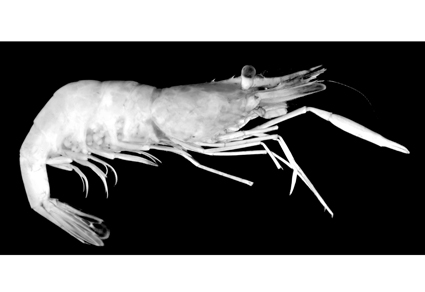Abstract
A new species of the palaemonid genus Paraclimenes is described from relatively deep water in New Zealand. The new species can easily be distinguished from the only other two known species in the genus by the non-spatulate chela of the first pereiopod, the size of the uropods and the produced distal telson margin.
References
- Bruce, A.J. (1967) Notes on some Indo-Pacific Pontoniinae III–IX. Descriptions of some new genera and species from the western Indian Ocean and the South China Sea. Zoologische Verhandelingen, 87, 1–73.
- Bruce, A.J. (1969) Preliminary descriptions of sixteen new species of the genus Periclimenes Costa, 1844 (Crustacea, Decapoda Natantia, Pontoniinae). Zoologische Mededelingen Leiden, 43 (20), 253–278.
- Bruce, A.J. (1979) Records of some pontoniine shrimps from the South China Sea. Cahiers de l’Indo-Pacifique, 1 (2), 215–248.
- Bruce, A.J. (1990) Periclimenes franklini sp. nov., a new deep-sea shrimp from the Coral Sea (Crustacea: Decapoda: Palaemonidae). The Beagle: Records of the Museum and Art Galleries of the Northern Territory, 7, 55–64. https://doi.org/10.5962/p.262792
- Bruce, A.J. (1991) Crustacea Decapoda: Further deep-sea palaemonoid shrimps from New Caledonian waters. In: Crosnier, A. (Ed.), Résultats des campagnes MUSORSTOM. Vol. 9. Mémoires du Muséum national d’Histoire naturelle (A), Zoologie, 152, 299–411.
- Bruce, A.J. (1995) A synopsis of the Indo-West Pacific genera of the Pontoniinae (Crustacea: Decapoda: Palaemonidae). Koeltz Scientific Books, Königstein, 172 pp. [imprint 1994, published 16 March 1995]
- Chow, L.H., De Grave, S. & Tsang, L.M. (2021) Evolution of protective symbiosis in palaemonid shrimps (Decapoda: Caridea) with emphases on host spectrum and morphological adaptations. Molecular Phylogenetics and Evolution, 162, e107201, 1–12. https://doi.org/10.1016/j.ympev.2021.107201
- Costa, O.G. (1844) Su due nuovi generi di Crostacei decapodi macrouri. Annali delle Accademia degli Aspiranti Naturalisti Napoli, 2, 285–292.
- De Grave, S. & Fransen, C.H.J.M. (2011) Carideorum catalogus: the recent species of the Dendrobranchiate, Stenopodidean, Procarididean and Caridean shrimps (Crustacea: Decapoda). Zoologische Mededelingen Leiden, 85, 195–589.
- Horká, I., De Grave, S., Fransen, C.H.J.M., Petrusek, A. & Ďuriš, Z. (2016) Multiple host switching events shape the evolution of symbiotic palaemonid shrimps (Crustacea: Decapoda). Scientific Reports, 6 (1), e26486, 1–13. https://doi.org/10.1038/srep26486
- Jones, E.G., Morrison, M.A., Davey, N., Mills, S., Pallentin, A., George, S., Kelly, M. & Tuck, I. (2018) Biogenic habitats on New Zealand’s continental shelf. Part II: National field survey and analysis. New Zealand Aquatic Environment and Biodiversity Report, 202, 1–261.
- Li, X. (2004) Report on some pandalid and pontoniine shrimps from the Chinese seas (Crustacea, Decapoda, Caridea). Acta Zootaxonomica Sinica, 29, 820–825.
- Li, X. & Bruce, A.J. (2006) Further Indo-Pacific palaemonoid shrimps (Crustacea: Decapoda: Palaemonoidea), principally from the New Caledonian region. Journal of Natural History, 40, 611–738. https://doi.org/10.1080/00222930600763627
- Li, X., Bruce, A.J. & Manning, R.B. (2004) Some palaemonid shrimps (Crustacea: Decapoda) from northern South China Sea, with descriptions of two new species. Raffles Bulletin of Zoology, 52 (2), 513–553.
- Park, J.-H. & Fransen, C.H.J.M. (2021) Redescription of Paraclimenes gorgonicola (Bruce, 1969) (Crustacea: Decapoda: Palaemonidae) and establishing P. franklini (Bruce, 1990) as its junior synonym. Zootaxa, 4938 (4), 443–456. https://doi.org/10.11646/zootaxa.4938.4.4


